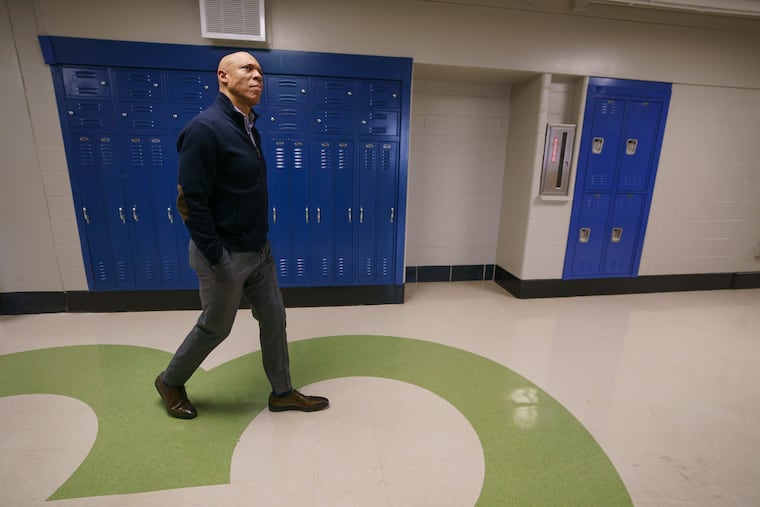Reopening plan for Philly schools exposes bigger weaknesses in system | Editorial
How to deliver education effectively — which experts agree requires on-site learning — and do it safely is a dilemma faced by all districts across the state and country. It falls particularly hard on some, like Philadelphia.

To answer the question “Could things get any worse?” the School District of Philadelphia released its plan Wednesday for reopening schools in September. This is not a swipe at the district, which takes its fair share of criticism, but rather the supremely impossible situation the pandemic — and our government’s response to it — has created for families and children.
Once again, the burden and pain will fall on the least privileged people. Once again, it’s a reckoning for a system whose structural weaknesses we have chosen to paper over rather than fully resolve.
» READ MORE: Philly’s school plan is out. Parents are panicked.
How to deliver education effectively — which experts agree requires on-site learning — and do it safely is a dilemma faced by all districts across the state and country. It falls particularly hard on some, like Philadelphia.
The district’s plan calls for two days a week of in-person instruction for most students, with the rest of the time in virtual instruction at home. It also offers an option for parents to enroll children in a ”digital academy,” for full-time virtual learning. The plan also calls for sanitizing and deep cleaning of schools, students staying in cohorts without changing classrooms, and smaller class sizes.
It’s not the best option — the best option is one in which there is no pandemic — but it’s the option that the district can afford. The plan will cost between $60 million and $80 million.
» READ MORE: Philly mom in Hong Kong: What returning to school after COVID-19 was really like | Perspective
It’s one of the many variations that districts are coming up with, where reopening plans are based on a number of factors, including both political and parental pressure. That underscores the failure of the government to provide a clear plan forward. Its pressure for businesses to reopen has led to a new spike in cases. Now there is pressure from the president and the secretary of education to reopen schools without the proper guidance to ensure the safety of teachers, staff, and children. Science is not driving these decisions, politics and the economy are.
Like all plans made in 2020, the school plan is predicated on the idea that plans could — and probably will — change again. Big concerns remain, including:
Different and wildly diverse needs: Younger students need different things than older students, educationally and socially. Special-education students have more complicated needs. The district must solve for thousands of low-income families with no internet access. Working parents who don’t have the luxury of working from home have just been handed a very challenging curveball.
One size doesn’t fit all. This pandemic has exposed just how challenging our expectations are for a public educational system to effectively serve everyone.
» READ MORE: COVID forced working moms like me to prove we’re superheroes. But how long can we last? | Opinion
A drive to the cybers: The plans for this and other districts could drive parents to enroll in one of the 14 cyber charter schools in the state. That’s troubling for two reasons:
A recent report on charter-school performance in Pennsylvania from Stanford University found that cyber charters show overwhelmingly negative results in the academic growth of students. This sector, which last year educated over 30,000 students and represents $463 million in spending, is not only not bringing improvements, but actually making the situation worse. Spikes in cyber enrollment will further diminish the money the districts have since charter tuitions come out of district budgets.
To be clear: These cyber charters are distinct from the Philadelphia School District’s “digital academies.” But not all districts have the capability for online learning. (Those digital academies are separate from the online learning that will take place on days students are not in schools.)
Transportation: Many schoolkids use SEPTA to travel to school. Who will monitor social distancing and mask-wearing?
» READ MORE: Should kids return to school in September? | Pro/Con
Money: Heavier cleaning, smaller classrooms, and other protocols will require more staffing, including aides, teachers, and maintenance crews. Some of the money comes from the federal government, possibly from a new “HEROES Act” bill currently in Congress. The governor and the General Assembly have yet to disburse some of the money from the CARES Act. The business community should also find ways to be part of the solution.
The pandemic has exposed frailties in our systems, especially education. Philadelphia’s schoolchildren, already shouldering the burden of this inequitable system, will once again be harmed. The best we can do is mitigate that harm. But “fingers crossed” is no way to move a nation and its children forward.
» READ MORE: Schools can’t reopen safely without better COVID testing for kids, say these Philly pediatricians l Expert Opinion